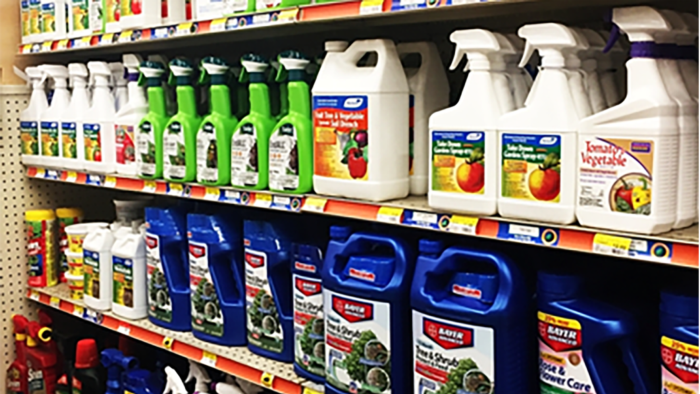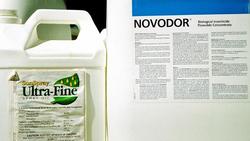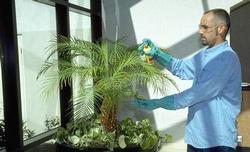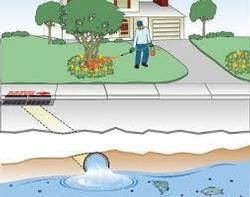When & How to Use Pesticides

> Reading pesticide labels
> Before you start
> Using & storing garden chemicals
> Keeping pesticides out of our waterways
> Disposing of pesticides & fertilizers
How to choose the right pesticide
If a pesticide is needed, select one that is:
• Effective against your pest
• Poses the least risks to human health and the environment
• Controls the pest at the correct stage (e.g., adult vs larval insect, preventive vs curative fungicide)
Choose the least-toxic pesticide that will solve your problem. Examples of least-toxic insecticides include insecticidal plant-based oils, soaps, and the microbial insecticide Bacillus thuringiensis. Check out UC IPM’s Less Toxic Insecticides and Bee precaution pesticide ratings for more detailed product information.
An easy way to find less toxic products is look for the “OMRI Listed” seal on the product label. The Organic Materials Review Institute (OMRI) is a nonprofit organization that provides an independent review of products intended for use in certified organic production, handling, and processing. OMRI acts as a third-party certifier. The seal indicates a product has been reviewed and approved for organic growing. You can find a free OMRI Products List here. Remember that the safety (toxicity) of any pesticide product is indicated by the signal word on the product label. OMRI listed products may carry Danger or Warning labels.

• The particular type of plant or site you plant to treat is listed on the label
• The pesticide is labeled for use on plants that will be eaten
• The pesticide is not labeled for "outdoor use only" if intended use is indoors
Pesticide labels – read before you use!
All pesticides legally marketed in the U.S. must have a label approved by the EPA. The product label is a legal document required for registering a pesticide. It provides information on the safe handling and use of pesticide products and will help you achieve maximum benefits from the product with minimum risk.
Information contained on a pesticide label includes:
• Trade name or brand name
• Active ingredients and their percentage by weight
• Types of plants or sites where pesticide may be used
• Pests targeted
• How much to use
• How and when to apply
• Required protective clothing and equipment
• Signal words (DANGER, WARNING, or CAUTION)
• Precautionary statements defining hazards to people, domestic animals, or the environment
• Emergency and first aid measures to take if someone has been exposed
• Proper storage and disposal of the pesticide and empty containers
Before you start

• Buy ready-to-use products when possible, so you don't have to measure and mix them.
• Don’t water after applying garden chemicals unless the label tells you to
• Never let pesticide run off into storm drains.
• Avoid applying chemicals outdoors when rain is forecast or when it is windy.
• Don't apply pesticides or fertilizers on paved surfaces.
Using and storing garden chemicals
• Always wear shoes, a long-sleeved shirt, pants, eye protection, and any other equipment listed on the product label.
• Properly measure concentrated formulations of pesticides.
• Keep all measuring tools for the garden separate from those used for food.
• Never apply more product than the amount listed on the label.
• Store all chemicals in the original labeled containers in a locked cabinet or shed, away from food or feeds, and out of the reach of children, and animals. Learn more about storage here.
• Never place pesticides in food or drink containers.
For help in an emergency, call the California Poison Control System at 1-800-222-1222. Visit the California Poison Control System for more information.
Keep pesticides out of our waterways

• Be aware of weather patterns and do not apply pesticides just prior to rainfall or during windy conditions.
• Avoid applying pesticides to hard surfaces such as sidewalks or driveways, where they can easily be washed off.
• Check pesticide labels for warnings regarding use near bodies of water such as streams, rivers, and lakes.
• Do not clean application equipment in a location where rinse water could flow into gutters, storm drains, or open waterways.
• Never apply more than the rate listed on a pesticide label.
Disposing of pesticides and fertilizers
• Pouring garden chemicals into a storm drain, down the sink, or into the toilet pollutes water and is against the law!
• The only allowable way to dispose of pesticides is to use them up according to label directions, or to take them to a household hazardous waste site.
